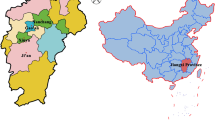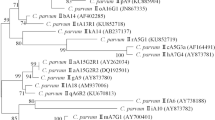Abstract
Cryptosporidium parvum is a ubiquitous zonootic parasite causing enteritis in man and animals. Cryptosporidium infection was confirmed microscopically in neonatal calves (less than 6 weeks of age) at Kafr El Sheikh Province, Egypt. Multilocus analysis using a wide array of genetic markers was carried out to assess genetic diversity of C. parvum isolates. PCR amplification and partial sequence analysis of 70 kDa heat shock protein, dihydrofolate reductase, alpha-tubulin, elongation factor 1 alpha as well as thrombospondin-related anonymous protein of Cryptosporidium-1, and thrombospondin-related anonymous protein of Cryptosporidium-2 gene markers were achieved. Data indicated that the analyzed isolates belong to C. parvum genotype II with obvious sequence heterogeneity compared with counterparts deposited in Genebank.


Similar content being viewed by others
References
Abdel-Messih I, Wierzba T, Abu-Elyazeed R, Ibrahim A, Ahmed S, Kamal K, Sanders J, Frenck R (2005) Diarrhea associated with Cryptosporidium parvum among young children of the nile river delta in Egypt. J Trop Pediatr 51:154–159
Abrahamsen M, Templeton T, Enomoto S, Abrahante J, Zhu G, Lancto C, Deng M, Liu C, Widmer G, Tzipori S, Buck G, Xu P, Bankier A, Dear P, Konfortov B, Spriggs H, Iyer L, Anantharaman V, Aravind L, Kapur V (2004) Complete genome sequence of the apicomplexan, Cryptosporidium parvum. Science 304:441–445
Alves M, Xiao L, Sulaiman I, Lal AA, Matos O, Antunes F (2003) Subgenotype analysis of Cryptosporidium isolates from humans, cattle, and zoo ruminants in Portugal. J Clin Microbiol 41:2744–2747
Amer S, Osman S, Mehres A (2002) Studies on cryptosporidiosis in Friesian calf with special references to hematology and immune response. Proc Int Conf Biol Sci ICBS 2:185–195
Amer S, Honma H, Ikarashi M, Tada C, Fukuda Y, Suyama Y, Nakai Y (2010) Cryptosporidium genotypes and subtypes in dairy calves in Egypt. Vet Parasitol 169:382–386
Bonafonte M, Priest J, Garmon D, Arrowood M, Mead J (1997) Isolation of the gene coding for elongation factor-1alpha in Cryptosporidium parvum. Biochim Biophys Acta 1351:256–260
Brook E, Anthony Hart C, French N, Christley R (2009) Molecular epidemiology of Cryptosporidium subtypes in cattle in England. Vet J 179:378–382
Caccio S, Thompson R, McLauchlin J, Smith H (2005) Unravelling Cryptosporidium and Giardia epidemiology. Trends Parasitol 21:430–437
Casemore D, Armstrong M, Sands R (1985) Laboratory diagnosis of cryptosporidiosis. J Clin Pathol 38(12):1337–1341
Chalmers R, Davies A (2010) Minireview: clinical cryptosporidiosis. Exp Parasitol 124:138–146
Coklin T, Farber J, Parrington L, Dixon B (2007) Prevalence and molecular characterization of Giardia duodenalis and Cryptosporidium spp. in dairy cattle in Ontario, Canada. Vet Parasitol 150:297–305
Coklin T, Uehlinger F, Farber J, Barkema H, O'Handley R, Dixon B (2009) Prevalence and molecular characterization of Cryptosporidium spp. in dairy calves from 11 farms in Prince Edward Island, Canada. Vet Parasitol 160:323–326
DuPont H, Chappell C, Sterling C, Okhuisen P, Rose J, Jakubowski W (1995) The infectivity of Cryptosporidium parvum in healthy volunteers. N Engl J Med 332:855–859
Eck R, Dayhoff M (1966) Atlas of protein sequence and structure. National Biomedical Research Foundation, Silver Springs, Maryland
Elwin K, Chalmers R, Roberts R, Guyl E, D Casemore (2001) Modification of a rapid method for the identification of gene-specific polymorphisms in Cryptosporidium parvum and its application to clinical and epidemiological investigations. Appl Environ Microbiol 67:5581–5584
Fayer R, Morgan U, Upton S (2000) Epidemiology of Cryptosporidium: transmission, detection and identification. Int J Parasitol 30:1305–1322
Felsenstein J (1985) Confidence limits on phylogenies: an approach using the bootstrap. Evolution 39:783–791
Gibbons C, Gazzardb B, Ibrahim M, Morris-Jonesb S, Ong C, Awad-El-Kariem F (1998) Correlation between markers of strain variation in Cryptosporidium parvum: evidence of clonality. Parasitol Int 47:139–147
Jex A, Pangasa A, Campbell B, Whipp M, Hogg G, Sinclair M, Stevens M, Gasser R (2008) Classification of Cryptosporidium species from patients with sporadic cryptosporidiosis by use of sequence-based multilocus analysis following mutation scanning. J Clin Microbiol 46:2252–2262
Khramtsov N, Tilley M, Blunt D, Montelone B, Upton S (1995) Cloning and analysis of a Cryptosporidium parvum gene encoding a protein with homology to cytoplasmic form Hsp70. J Eukaryot Microbiol 42:416–422
MacDonald L, Armson A, Thompson R, Reynoldson J (2003) Characterization of factors favoring the expression of soluble protozoan tubulin proteins in Escherichia coli. Protein Expr Purif 29:117–122
Misic Z, Abe N (2007) Subtype analysis of Cryptosporidium parvum isolates from calves on farms around Belgrade, Serbia and Montenegro, using the 60 kDa glycoprotein gene sequences. Parasitol 134:351–358
Nei M, Kumar S (2000) Molecular evolution and phylogenetics. Oxford University Press, New York
Opitz C, Soldati D (2002) The glideosome': a dynamic complex powering gliding motion and host cell invasion by Toxoplasma gondii. Mol Microbiol 45:597–604
Peng M, Xiao L, Freeman A, Arrowood M, Escalante A, Weltman A, Ong C, Mac Kenzie W, Lal A, Beard C (1997) Genetic polymorphism among Cryptosporidium parvum isolates: evidence of two distinct human transmission cycles. Emerg Infect Dis 3:567–573
Perz J, Le Blancq S (2001) Cryptosporidium parvum infection involving novel genotypes in wildlife from lower New York State. Appl Environ Microbiol 67:1154–1162
Putignani L, Possenti A, Cherchi S, Pozio E, Crisanti A, Spano F (2008) The thrombospondin-related protein CpMIC1 (CpTSP8) belongs to the repertoire of micronemal proteins of Cryptosporidium parvum. Mol Biochem Parasitol 157:98–101
Saitou N, Nei M (1987) The neighbor-joining method: a new method for reconstructing phylogenetic trees. Mol Biol Evol 4:406–425
Satoh M, Kimata I, Iseki M, Nakai Y (2005) Gene analysis of Cryptosporidium parvum HNJ-1 strain isolated in Japan. Parasitol Res 97:452–457
Smith H, Rose J (1998) Waterborne cryptosporidiosis: current status. Parasitol Today 4:14–22
Spano F, Putignani L, Naitza S, Puri C, Wright S, Crisanti A (1998) Molecular cloning and expression analysis of a Cryptosporidium parvum gene encoding a new member of the thrombospondin family. Mol Biochem Parasitol 92:147–162
Sturdee A, Chalmers R, Bull S (1999) Detection of Cryptosporidium oocysts in wild animals of mainland Britain. Vet Parasitol 80:273–280
Sulaiman I, Xiao L, Yang C, Escalante L, Moore A, Beard C, Arrowood M, Lal A (1998) Differentiating human from animal isolates of Cryptosporidium parvum. Emerg Infect Dis 4:681–685
Sulaiman I, Morgan U, Thompson R, Lal A, Xiao L (2000) Phylogenetic relationships of Cryptosporidium parasites based on the 70 kilodalton heat shock protein (HSP70) gene. Appl Environ Microbiol 66:2385–2391
Sulaiman I, Lal A, Xiao L (2001) A population genetic study of the Cryptosporidium parvum human genotype parasites. J Eukaryot Microbiol 48(S1):24S–27S
Tamura K, Nei M, Kumar S (2004) Prospects for inferring very large phylogenies by using the neighbor-joining method. PNAS 101:11030–11035
Tamura K, Dudley J, Nei M, Kumar S (2007) MEGA4: Molecular Evolutionary Genetics Analysis (MEGA) software version 4.0. Mol Biol Evol 24:1596–1599
Tanriverdi S, Grinberg A, Chalmers RM, Hunter P, Petrovic Z, Akiyoshi D, London E, Zhang L, Tzipori S, Tumwine JK, Widmer G (2008) Inferences about the global population structures of Cryptosporidium parvum and Cryptosporidium hominis. Appl Environ Microbiol 74:7227–7234
Tzipori S, Widmer G (2008) A hundred-year retrospective on cryptosporidiosis. Trends Parasitol 24:184–189
Vasquez J, Gooze L, Kim K, Gut J, Petersen C, Nelson R (1996) Potential antifolate resistance determinants and genotypic variation in the bifunctional dihydrofolate reductase-thymidylate synthase gene from human and bovine isolates of Cryptosporidium parvum. Mol Biochem Parasitol 79:153–165
Wade S, Mohammed H, Schaaf S (2000) Prevalence of Giardia sp., Cryptosporidium parvum and Cryptosporidium muris (C. andersoni) in 109 dairy herds in five counties of southeastern New York. Vet Parasitol 93:1–11
Wielinga P, de Vries A, van der Goot T, Mank T, Mars M, Kortbeek L, van der Giessen J (2008) Molecular epidemiology of Cryptosporidium in humans and cattle in The Netherlands. Intl J Parasitol 38:809–817
Youssef F, Adib I, Riddle M, Schlett C (2008) A review of cryptosporidiosis in Egypt. J Egypt Soc Parasitol 38:9–28
Author information
Authors and Affiliations
Corresponding author
Rights and permissions
About this article
Cite this article
Amer, S., Fayed, M., Honma, H. et al. Multilocus genetic analysis of Cryptosporidium parvum from Egypt. Parasitol Res 107, 1043–1047 (2010). https://doi.org/10.1007/s00436-010-1967-y
Received:
Accepted:
Published:
Issue Date:
DOI: https://doi.org/10.1007/s00436-010-1967-y




